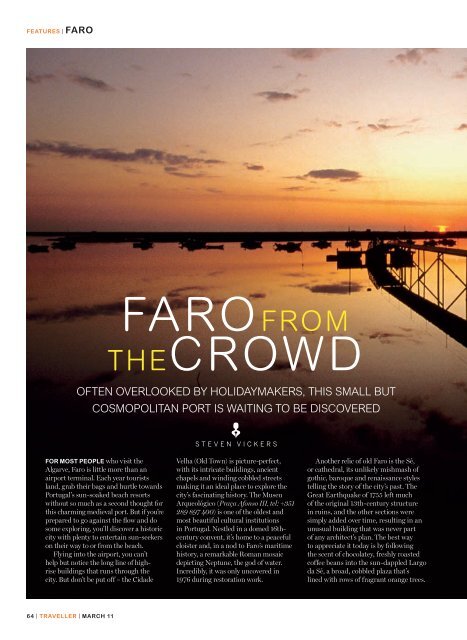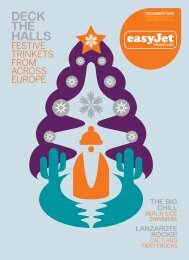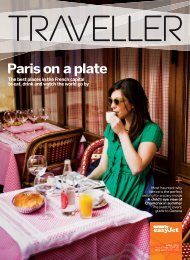You also want an ePaper? Increase the reach of your titles
YUMPU automatically turns print PDFs into web optimized ePapers that Google loves.
FEATURES | FARO<br />
FOR MOST PEOPLE who visit the<br />
Algarve, Faro is little more than an<br />
airport terminal. Each year tourists<br />
land, grab their bags and hurtle towards<br />
Portugal’s sun-soaked beach resorts<br />
without so much as a second thought for<br />
this charming medieval port. But if you’re<br />
prepared to go against the fl ow and do<br />
some exploring, you’ll discover a historic<br />
city with plenty to entertain sun-seekers<br />
on their way to or from the beach.<br />
Flying into the airport, you can’t<br />
help but notice the long line of highrise<br />
buildings that runs through the<br />
city. But don’t be put off – the Cidade<br />
64 | TRAVELLER | MARCH 11<br />
FARO FROM<br />
THECROWD<br />
OFTEN OVERLOOKED BY HOLIDAYMAKERS, THIS SMALL BUT<br />
COSMOPOLITAN PORT IS WAITING TO BE DISCOVERED<br />
STEVEN VICKERS<br />
Velha (Old Town) is picture-perfect,<br />
with its intricate buildings, ancient<br />
chapels and winding cobbled streets<br />
making it an ideal place to explore the<br />
city’s fascinating history. The Museu<br />
Arqueológico (Praça Afonso III, tel: +351<br />
289 897 400) is one of the oldest and<br />
most beautiful cultural institutions<br />
in Portugal. Nestled in a domed 16thcentury<br />
convent, it’s home to a peaceful<br />
cloister and, in a nod to Faro’s maritime<br />
history, a remarkable Roman mosaic<br />
depicting Neptune, the god of water.<br />
Incredibly, it was only uncovered in<br />
1976 during restoration work.<br />
Another relic of old Faro is the Sé,<br />
or cathedral, its unlikely mishmash of<br />
gothic, baroque and renaissance styles<br />
telling the story of the city’s past. The<br />
Great Earthquake of 1755 left much<br />
of the original 13th-century structure<br />
in ruins, and the other sections were<br />
simply added over time, resulting in an<br />
unusual building that was never part<br />
of any architect’s plan. The best way<br />
to appreciate it today is by following<br />
the scent of chocolatey, freshly roasted<br />
coffee beans into the sun-dappled Largo<br />
da Sé, a broad, cobbled plaza that’s<br />
lined with rows of fragrant orange trees.















